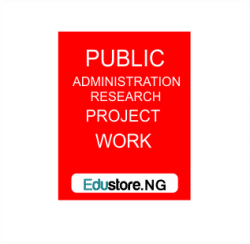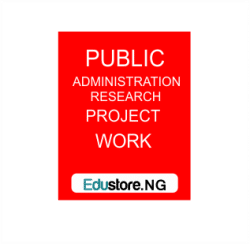Performance Management, A New Strategy For Improving Public Sectors Effectiveness
ABSTRACT
Performance Management processes have become prominent in recent years as means of providing a more integrated and continuous approach to the management of performance in the Public Sector of the economy. Performance management is based on the principles of Management by Agreement or contract, rather than management by command. It emphasizes development and the initiation of self-managed learning plans as well as the integration of individual and corporate objectives. It can, in fact, play a major role in providing for an integrated and coherent range of human resource management processes which are mutually supportive and contribute as a whole to improving organizational effectiveness, as it is forward-looking and developmental. It provides a framework in which managers can support their team members rather than dictate to them, and its impact on results will be much more significant if it is regarded as a transformational rather than as an appraisal process. The overarching objective of Human Resources Management is to contribute to the achievement of high levels of organizational performance. The integration of human resources and business strategies will generally focus on this goal. Boxall and Purcell (2003) suggests that: ‘‘Human Resource advantage can be traced to better people employed in organizations with better processes’’. This echoes the resource-based view of the organization which states that ‘distinctive human resource practices help to create the unique competencies that determine how organizations compete, (Capelli and Cracker-Hefter, 1996). Performance goals within the public service can be achieved with the help of high performance work systems which take into account the factors affecting individual performance and promote flexibility. They also include rigorous recruitment and selection procedures, performance-contingent incentive compensation systems, and management development and training activities linked to the needs of the organization, (Becker et al, 1997). As defined by Boxall and Purcell (2003), the level of individual performance is a function of ability, motivation, and opportunity (AMO). People perform well when they are able to do so, (they can do the job because they have the necessary abilities and skills); when they have the motivation to do so, (they will do the job because they want to and are adequately incentivized); and when their work environment provides the necessary support and avenues for expression, (for example, functioning technology and the opportunity to be heard when problems occur). It is based on the above premises that this research study is conducted on Performance Management as a new strategy for improving public sectors effectiveness, vis-à-vis, the relationship between Human Resources Management and Performance Management, with the hope that people can make an impact on performance, by leading or contributing to the development and successful implementation of high performance work practices, particularly those concerned with job and work design, flexible working, resourcing (increasing skills and extending the skills base), reward and giving employees a voice; the formulation and embedding of a clear vision and set of values (the big idea); the development of a positive psychological contract and means of increasing the motivation and commitment of employees, the formulation and implementation of policies which in the words of Purcell et al (2003), meet the needs of individuals and ‘‘create a great place of work’’; the provision of support and advice to line managers on their role in the implementation of human resources policies and practices; and the effective management of change.
TABLES OF CONTENTS
Pages
Cover page
Title page … … … … … … … … … … i
Certification … … … … … … … … … ii
Dedication … … … … … … … … … iii
Acknowledgement … … … … … … … … iv
Abstract … … … … … … … … … … v
Table of Contents … … … … … … … … viii
CHAPTER ONE
- Background of the Study … … … … … … 1
- Statement of the Problem … … … … … … 5
- Purpose (Objective) of the Study … … … … 6
- Research Questions … … … … … … … 7
- Statement of the Hypotheses … … … … … 7
- Significance of the Study … … … … … … 8
- Assumptions of the Study … … … … … … 9
- Scope and Limitation of the Study … … … … 10
- Delimitation of the Study … … … … … … 11
- Definition of Terms … … … … … … … 11
- Brief History of Ministry of transport, Uyo … … 13
CHAPTER TWO: REVIEW OF RELATED LITERATURE AND THEORETICAL FRAMEWORK
2.1 Review of Literature … … … … … … 20
2.2 Theoretical Framework: Definition … … … 21
2.2.1 The Meaning of Performance … … … … … 22
2.3 Concerns of Performance Management … … … 24
2.4 Ethical Consideration … … … … … … 25
2.5 The Scope of Performance Management … … 26
2.5.1 The Holistic Approach to Performance Management 27
2.5.2 The Concept of Performance Management as an
Integrating Force … … … … … … … 28
2.6 The Process of Performance Management … … 28
2.7 Performance Management Key Activities … … 29
2.7.1 Role Profile … … … … … … … … 30
2.7.2 The Performance Agreement or Contract … … 30
2.7.3 The Personal Development Plan … … … … 31
2.7.4 Managing Performance Throughout the Year … 31
2.7.5 Performance Review … … … … … … 32
2.8 Monitoring and Evaluating Performance Management 33
2.9 The 360-Degree Feedback … … … … … 34
2.9.1 Use of 360-Degree Feedback … … … … 35
2.9.2 Rationale for 360-Degree Feedback … … … 36
2.9.3 360-Degree Feedback: Advantages and
Disadvantages … … … … … … … 37
2.9.4 360-Degree Feedback: Criteria for Success … 39
2.10 Performance Appraisal Feedback … … … … 40
2.10.1 Types of Performance Appraisal … … … … 41
2.10.2 Effective Performance Feedback … … … … 43
2.10.3 Advantages of Effective Performance Feedback … 45
2.11 Developing A Performing Workforce … … … 46
2.11.1 Training and Development … … … … … 46
2.11.2 Mentoring … … … … … … … … … 47
2.11.3 Corporate Universities … … … … … … 48
2.11.4 Promotion from Within … … … … … … 49
2.12 Performance Reinforcement Tools … … … 49
2.12.1 Reinforcement Tools … … … … … … 51
CHAPTER THREE: RESEARCH METHODOLOGY
- Introduction … … … … … … … … 54
- Research Design … … … … … … … 54
- Population of Study … … … … … … … 55
- Sample and Sampling Technique … … … … 55
- Instrumentation … … … … … … … 56
- Validation of Instrument … … … … … … 56
- Methods of Data Collection … … … … … 57
- Methods of Data Analysis … … … … … … 57
CHAPTER FOUR: DATA PRESENTATION AND ANALYSIS
-
-
- Introduction … … … … … … … … 59
- Research Question I … … … … … … 60
- Research Question II … … … … … … 61
- Research Question III … … … … … … 63
- Research Question IV … … … … … … 64
- Research Question V … … … … … … 66
-
CHAPTER FIVE: SUMMARY, CONCLUSION AND RECOMMENDATIONS
-
- 5.0 Introduction … … … … … … … … 68
-
- 5.1 Summary … … … … … … … … 68
-
- 5.2 Conclusion … … … … … … … … 69
-
- 5.3 Recommendation … … … … … … … 71
-
- References … … … … … … … … 73
- Appendix I … … … … … … … … 75
Download This Project Material Now!!
- For Reference Only: Materials are for research, citation, and idea generation purposes and not for submission as your original final year project work.
- Avoid Plagiarism: Do not copy or submit this content as your own project. Doing so may result in academic consequences.
- Use as a Framework: This complete project research material should guide the development of your own final year project work.
- Academic Access: This platform is designed to reduce the stress of visiting school libraries by providing easy access to research materials.
- Institutional Support: Tertiary institutions encourage the review of previous academic works such as journals and theses.
- Open Education: The site is maintained through paid subscriptions to continue offering open access educational resources.






